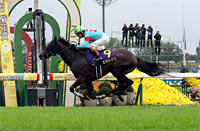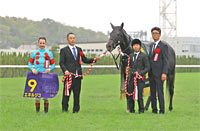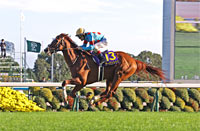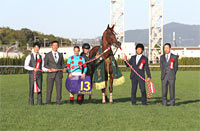Kikuka Sho (Japanese St. Leger) (G1) - Data Analysis
Final 3-year-old classic boasting a string of famous winners
Of all the Kikuka Sho winners since 1984 (the year when the grade system was introduced), 17 have gone on to win JRA Grade 1 races for older horses (3yo+ or 4yo+). This is the highest number for any 3-year-old G1 race – more than the Oka Sho with 7, the Satsuki Sho with 14, the NHK Mile Cup with 4, the Yushun Himba (Japanese Oaks) with 7, the Tokyo Yushun (Japanese Derby) with 11 and the Shuka Sho with 9 (in all cases, as of the end of 2017 summer racing). As well as being the final hurdle of the 3-year-old classics, this could also be seen as an important race offering pointers to future success in G1 races for older horses. This time, let's analyze some features shared by successful runners in this race from results over the last 10 years.
Race favors strong performers last time out
Of 30 Top 3 finishers over the last 10 years, 26 had finished "In the Top 3" in their previous outing. By contrast, no horse finishing "4th or lower" last time out has won this race, runners in that category managing a paltry Top 3 ratio of only 4.9%. Basically, this is a race that favors strong performers last time out. [Table 1]
[Table 1] Performance by finish last time out (last 10 years)
| Finish last time out |
Performance
[1st-2nd-3rd-4th or lower] |
Win ratio |
Top 2 ratio |
Top 3 ratio |
| In the Top 3 |
10-9-7-73 |
10.1% |
19.2% |
26.3% |
| 4th or lower |
0-1-3-77 |
0% |
1.2% |
4.9% |
Of those finishing “4th or lower” last time out, 34 had contested in “Races other than the Kobe Shimbun Hai” in that previous outing, but none of them finished in the Top 3 here. We should have particularly low expectations of runners beaten to 4th or lower in warmup races other than the Kobe Shimbun Hai. [Table 2]
[Table 2] Performance by previous outing of horses finishing “4th or lower” in that race (last 10 years)
| Previous outing |
Performance
[1st-2nd-3rd-4th or lower] |
Win ratio |
Top 2 ratio |
Top 3 ratio |
| Kobe Shimbun Hai |
0-1-3-43 |
0% |
2.1% |
8.5% |
| Races other than Kobe Shimbun Hai |
0-0-0-34 |
0% |
0% |
0% |
Check the “closing speed” last time out
Of 30 Top 3 finishers over the last 10 years, 20 were ranked “In the first two” in the (estimated) final three furlong time in their most previous JRA race. Horses in this category also have excellent success ratios, including a Top 3 ratio of 30.8%. When comparing the runners’ performance in their previous outing, we should focus not only on the final placing order but also on the “closing speed.” [Table 3]
[Table 3] Performance by ranking in the (estimated) final three furlong time last time out when it was a JRA race (last 10 years)
| Ranking in (estimated) final three furlong time last time out |
Performance
[1st-2nd-3rd-4th or lower] |
Win ratio |
Top 2 ratio |
Top 3 ratio |
| In the first two |
8-7-5-45 |
12.3% |
23.1% |
30.8% |
| 3rd or lower |
2-3-5-104 |
1.8% |
4.4% |
8.8% |
Of horses most recently seen in JRA races and recording an (estimated) final three furlong time ranked “3rd or lower” in that race, those with no Top 4 finish experience in a “JRA G1 or G2 race after passing the 4th corner in 4th or higher position” have a Top 3 ratio of only 3.7% here. Horses seem more likely to struggle in this race if they not only failed to record a superior (estimated) final three furlong time among the runners in their last outing but have also never experienced a successful run after taking a front position in a G1 or G2 race. [Table 4]
[Table 4] Performance of horses ranked “3rd or lower” in the (estimated) final three furlong time in their previous outing when it was a JRA race, by Top 4 experience in a “JRA G1 or G2 race after passing the 4th corner in 4th or higher position (last 10 years)
| Experience |
Performance
[1st-2nd-3rd-4th or lower] |
Win ratio |
Top 2 ratio |
Top 3 ratio |
| Yes |
2-2-3-25 |
6.3% |
12.5% |
21.9% |
| No |
0-1-2-79 |
0% |
1.2% |
3.7% |
Focus on heavier horses and weight-gainers
Of 30 Top 3 finishers over the last 10 years, 22 had weighed in at “480kg or more” last time out. Conversely, horses with a body weight of “Less than 480kg” have enjoyed less success, with a Top 3 ratio of only 10.3%. We should not expect too much from horses with a body weight of “Less than 480kg” in their previous outing. [Table 5]
[Table 5] Performance by body weight last time out (last 10 years)
| Body weight last time out |
Performance
[1st-2nd-3rd-4th or lower] |
Win ratio |
Top 2 ratio |
Top 3 ratio |
| Less than 480kg |
2-2-4-70 |
2.6% |
5.1% |
10.3% |
| 480kg or more |
8-8-6-80 |
7.8% |
15.7% |
21.6% |
Similarly, horses whose body weight had “Increased by 10kg or more since the previous outing” last time out have posted impressive success ratios, including a Top 3 ratio of 36.4%. Of those falling into this category, nine had a body weight of “Less than 480kg” last time out; their aggregate performance is [1-2-0-6], including three Top 2 finishers. Even if the body weight was “Less than 480kg” last time out, it could be worth looking for a significant increase in body weight from the race before that (in other words, an increase over the summer season). [Table 6]
[Table 6] Performance by change in body weight last time out, compared to the race before that (last 10 years)
| Change in body weight last time out |
Performance
[1st-2nd-3rd-4th or lower] |
Win ratio |
Top 2 ratio |
Top 3 ratio |
| Increased by 10kg or more |
2-5-1-14 |
9.1% |
31.8% |
36.4% |
| Increased by less than 10kg, or decreased |
8-5-9-136 |
5.1% |
8.2% |
13.9% |
Discount horses with a change of rider
Of 30 Top 3 finishers over the last 10 years, 27 were ridden by the same jockey as their previous outings. By contrast, those ridden by a different jockey have struggled to impress, managing a Top 3 ratio of just 6.0%. Horses with a change of rider should not be estimated too highly. [Table 7]
[Table 7] Performance by jockey (last 10 years)
| Jockey |
Performance
[1st-2nd-3rd-4th or lower] |
Win ratio |
Top 2 ratio |
Top 3 ratio |
| Same as previous race |
10-8-9-103 |
7.7% |
13.8% |
20.8% |
| Change of rider |
0-2-1-47 |
0% |
4.0% |
6.0% |
Recent trend shows strong showing by horses with previous G1 success
Of 18 Top 3 finishers over the last six years, nine had previous Top 3 experience in JRA G1 races. Horses in this category also have outstandingly good success ratios, including a Top 3 ratio of 56.3%. Last year, there were four such runners, and they were the first four past the post. If our focus is on recent trends, the money should be on runners who have already experienced success in G1 races. [Table 8]
[Table 8] Performance by Top 3 experience in JRA G1 races (last 6 years)
| Experience |
Performance
[1st-2nd-3rd-4th or lower] |
Win ratio |
Top 2 ratio |
Top 3 ratio |
| Yes |
5-3-1-7 |
31.3% |
50.0% |
56.3% |
| No |
1-3-5-83 |
1.1% |
4.3% |
9.8% |
Of horses without previous Top 3 experience in JRA G1 races, only those with Top 4 experience in JRA G1 or G2 races over distances of 2,200m or more have finished in the Top 2 here. Horses without this experience have a measly Top 3 ratio of 1.9%. When comparing runners with no Top 3 experience in G1 races, we should focus on their record in G1 or G2 races over 2,200m or more. [Table 9]
[Table 9] Performance of horses without Top 3 experience in JRA G1 races, by experience of Top 4 finishes in JRA G1 or G2 races over 2,200m+ (last 6 years)
| Experience |
Performance
[1st-2nd-3rd-4th or lower] |
Win ratio |
Top 2 ratio |
Top 3 ratio |
| Yes |
1-3-4-30 |
2.6% |
10.5% |
21.1% |
| No |
0-0-1-53 |
0% |
0% |
1.9% |
Seek out the winner!
All recent winners occupied inner brackets
Each of the last five winners contested this race with horse numbers “1-4.” This year, then, we should start by focusing on runners occupying the inner brackets. Other statistics shared by these five are that they had finished “In the Top 3” in their previous outing, their body weight last time out was “480kg or more,” and they were ridden by the same jockey as last time out. The trends highlighted in Tables 1, 5 and 7 should also be borne in mind. [Table 10]
[Table 10] Winners by "Horse No. in the Kikuka Sho”, “Finish last time out”, “Body weight last time out”, “Jockey this time” and “Jockey last time” (last 5 years)
| Year |
Winning horse |
Horse No. |
Finish last time out |
Body weight last time out |
Jockey this time |
Jockey last time |
| 2012 |
Gold Ship |
1 |
1st |
498kg |
Hiroyuki Uchida |
Hiroyuki Uchida |
| 2013 |
Epiphaneia |
3 |
1st |
480kg |
Yuichi Fukunaga |
Yuichi Fukunaga |
| 2014 |
Toho Jackal |
2 |
3rd |
484kg |
Manabu Sakai |
Manabu Sakai |
| 2015 |
Kitasan Black |
4 |
1st |
532kg |
Hiroshi Kitamura |
Hiroshi Kitamura |
| 2016 |
Satono Diamond |
3 |
1st |
500kg |
Christophe Lemaire |
Christophe Lemaire |
(Masaya Ibuki) |





















